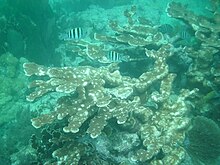Florida Reef
Isolated coral patch reefs occur northward from Biscayne National Park as far north as Stuart, in Martin County.
The bays and sounds (all between the Florida Keys and the mainland) tend to have lower salinity, higher turbidity and wider temperature variations than the water in the open ocean.
Closest to the Keys is a sand ridge called White Bank, covered by large beds of sea grass, with patch reefs scattered across it.
The hardbottom community lies closest to the Florida Keys and consists primarily of algae, sea fans (gorgonians) and stony corals growing on limestone rock that has a thin covering of sand.
Hardbottom provides habitat for anemones, mollusks, crabs, spiny lobsters, seastars, sea cucumbers, tunicates and various fish, including grunts (Haemulon spp.
Most of the structure of patch reefs is formed from star (Montastraea annularis, Siderastrea siderea) and brain corals (Diploria spp.).
Dome-type patch reefs are surrounded by sand which is kept clear due to browsing by long-spined sea urchins and grass-eating fish.
As dead coral skeletons age and are weakened by the activities of boring sponges, worms, and mollusks and by wave action, parts of a patch reef may collapse.
Patch reefs provide habitat for spiny lobsters and for many species of fish, including Bluehead wrasse (Thalassoma bifasciatum), damselfish (Chromis spp.
), sergeant major (Abudefduf saxatilis), tomtate (Haemulon aurolineatum), trumpetfish (Aulostomus maculatus), filefish, groupers, snappers, bar jack (Caranx ruber), great barracuda, pufferfish, squirrelfish, cardinalfish, and green morays (Gymnothorax funebris).
The reef flat is closest to the keys, and consists of coralline algae growing on fragments of coral skeletons.
Bank reefs provide habitat for various fishes, including French angelfish, blue and queen parrotfish, Queen triggerfish (Balistes vetula), rock beauties (Holacanthus tricolor), Goatfish (Parupeneus cyclostomus), porkfish (Anisotremus virginicus) and snappers.
[citation needed] Plant and animal life on coral reefs are quickly being destroyed due to pollution, overfishing, and climate change.
[citation needed] Animals known as polyps, which create the fundamental structure of a reef, die from ingesting tiny bits of trash floating throughout the ocean called microplastics.
Fluctuating ocean temperatures caused by global warming presents the largest threat to coral reefs.
The sudden warming or cooling of the water stresses the corals, causing them to lose their nutrients and turn white, a process known as bleaching.
With the destruction of these complex yet fragile ecosystems comes a wide range of global consequences such as extinction of marine species, endangerment to the fishing industries, and severe coastal erosion.
A joint reef monitoring program conducted by the United States Environmental Protection Agency, Florida Marine Research Institute and National Oceanic and Atmospheric Administration recorded a loss of 6% to 10% living corals at 40 sampling stations from 1996 to 2000.
Oceanographer Jamison Grove at the NOAA stated that these efforts must be accompanied by reductions in greenhouse gas emission to save the reef.
Other possible causes of the losses of corals on the Florida Reef include epizootic diseases, eutrophication, predation, sedimentation, overfishing, ship groundings, anchor dragging, commercial lobster and crab traps moved by storms, pollution, development on the Keys, growing numbers of visitors to the Keys and the reefs and the growth of seaweed on the coral.
While populations of this sea urchin have somewhat recovered elsewhere, its numbers are still very low on most of the Florida Reef, with the exception of the Dry Tortugas.
The lower salinity, higher turbidity and more variable temperature of the water from Florida Bay adversely affects the reefs.
In 2000-2001 artificial and natural reefs in South Florida[19] and Monroe County had 28 million person-days of recreational use by residents and tourists, including scuba diving, fishing and viewing (as, for example, by snorkeling).
[22] In a more general sense, the reef acts as a layer of protection for human settlements against tropical storms, hurricanes, and erosion.
In 1622, six ships of the Spanish treasure fleet, including the Nuestra Señora de Atocha, wrecked during a hurricane in the lower Keys.
In the 19th century the Straits became the major route for shipping between the eastern coast of the United States and ports in the Gulf of Mexico and the western Caribbean Sea.
The United States Army Corps of Topographical Engineers established a base camp on Key Biscayne in 1849.





